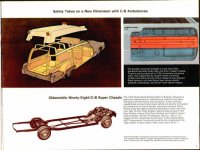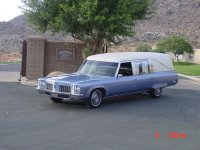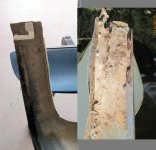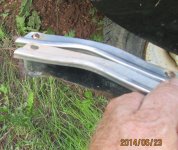Nicholas Studer
PCS Elected Director 2022-2025
I understand there really wasn't one so to speak. However, my 1970 Cotner-Bevington "Cotington 48," is based on the "Oldsmobile Ninety-Eight/C/B Super Chassis" From what I can tell, they modified it in-house. They specifically mention springs and shock absorbers, front disk brakes, rear brakes, and brake booster are "special." I've got a parts car now to work with for hood, fender, quarter panels, etc. - but mechanically I know there are likely differences. Further, over the course of this ambulance's 30 year career - it's quite possible something got switched out.
1. Are the wheels ambulance/hearse specific? They are on Cadillac as discussed at http://www.professionalcarsociety.org/forums/showthread.php?t=5329 . There were a bunch of old wheels/tires sitting with the car when I got it - as mentioned it was in the midst of a so-called "rebuild" when the previous to previous owner sold it. I wonder if any are the correct ones and some got swapped out. Got 'em all, but just something to think about.
2. How about master cylinder and brake booster? As discussed at http://www.professionalcarsociety.org/forums/showthread.php?t=13123 and specifically in the table listed at the bottom of the page - they were "special" on Cadillac with a 1" bore vs 1 1/8 for regular cars. I'll probably want to rebuild the original anyway - but want to be sure that one itself didn't get swapped out for the "wrong" one during its lifespan. It only shows a single model for Olds 98 on that same chart - but C/B ambulances were more uncommon than Cadillac. Are folks still using Apple Hydraulics? It seems they'll only do the master cylinder - any recommendation for the booster?
3. Are the wheel cylinders and front calipers different? NAPA lists Commercial Chassis specific parts for the Cadillac of same year.
4. Anything else I should be looking out for?
Thanks!
1. Are the wheels ambulance/hearse specific? They are on Cadillac as discussed at http://www.professionalcarsociety.org/forums/showthread.php?t=5329 . There were a bunch of old wheels/tires sitting with the car when I got it - as mentioned it was in the midst of a so-called "rebuild" when the previous to previous owner sold it. I wonder if any are the correct ones and some got swapped out. Got 'em all, but just something to think about.
2. How about master cylinder and brake booster? As discussed at http://www.professionalcarsociety.org/forums/showthread.php?t=13123 and specifically in the table listed at the bottom of the page - they were "special" on Cadillac with a 1" bore vs 1 1/8 for regular cars. I'll probably want to rebuild the original anyway - but want to be sure that one itself didn't get swapped out for the "wrong" one during its lifespan. It only shows a single model for Olds 98 on that same chart - but C/B ambulances were more uncommon than Cadillac. Are folks still using Apple Hydraulics? It seems they'll only do the master cylinder - any recommendation for the booster?
3. Are the wheel cylinders and front calipers different? NAPA lists Commercial Chassis specific parts for the Cadillac of same year.
4. Anything else I should be looking out for?
Thanks!





